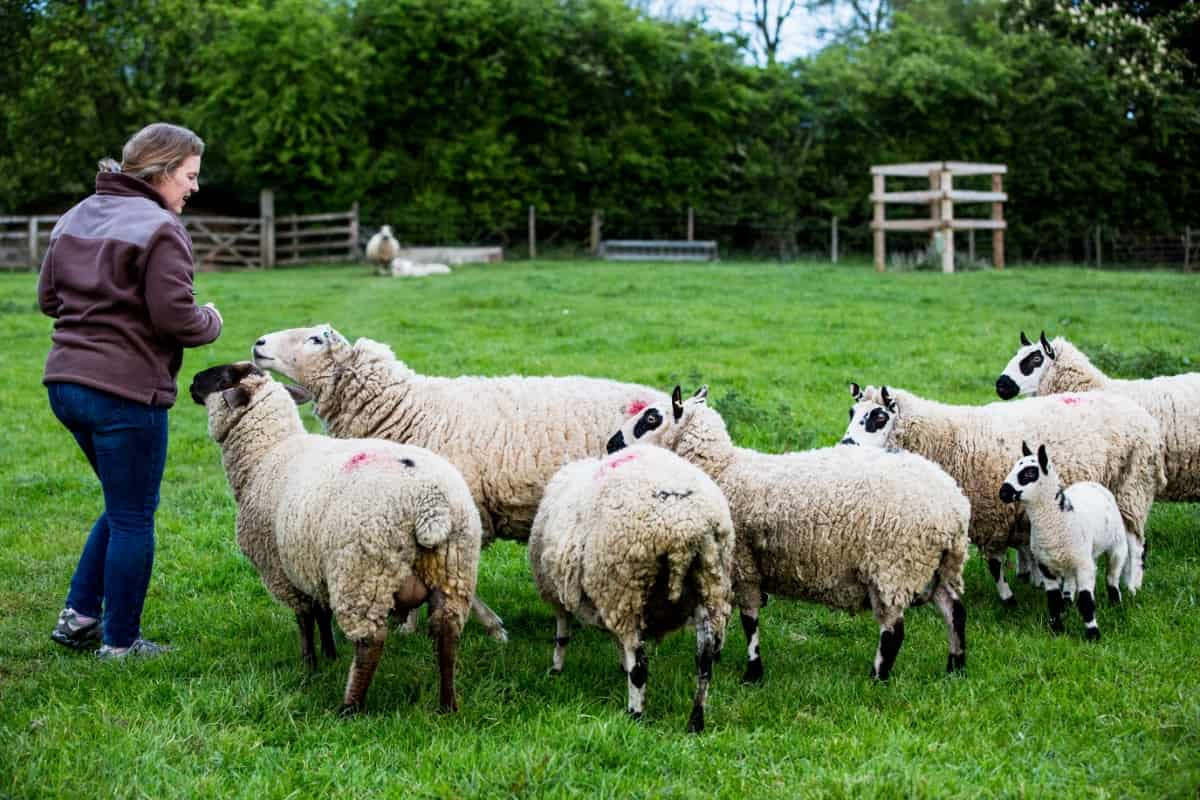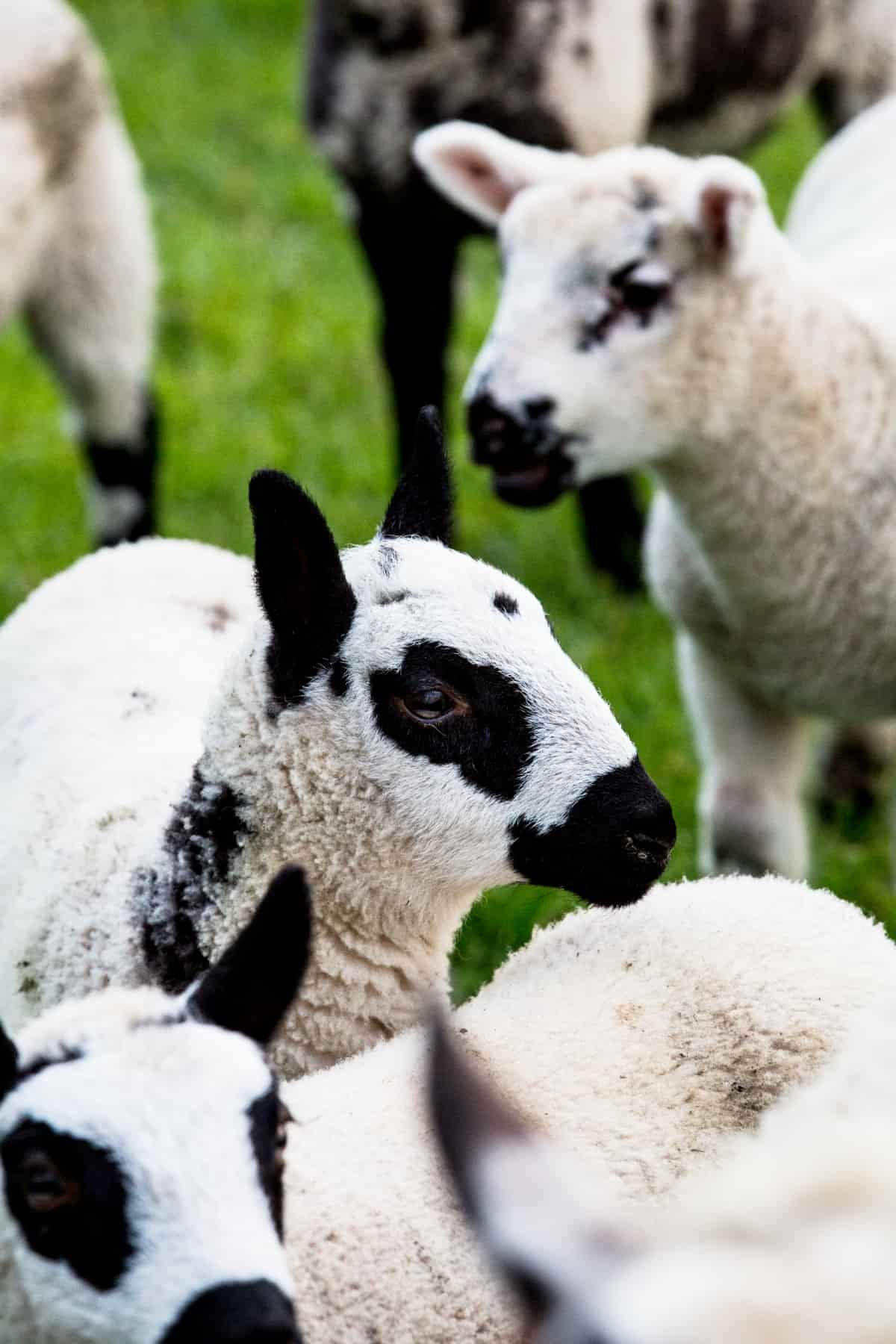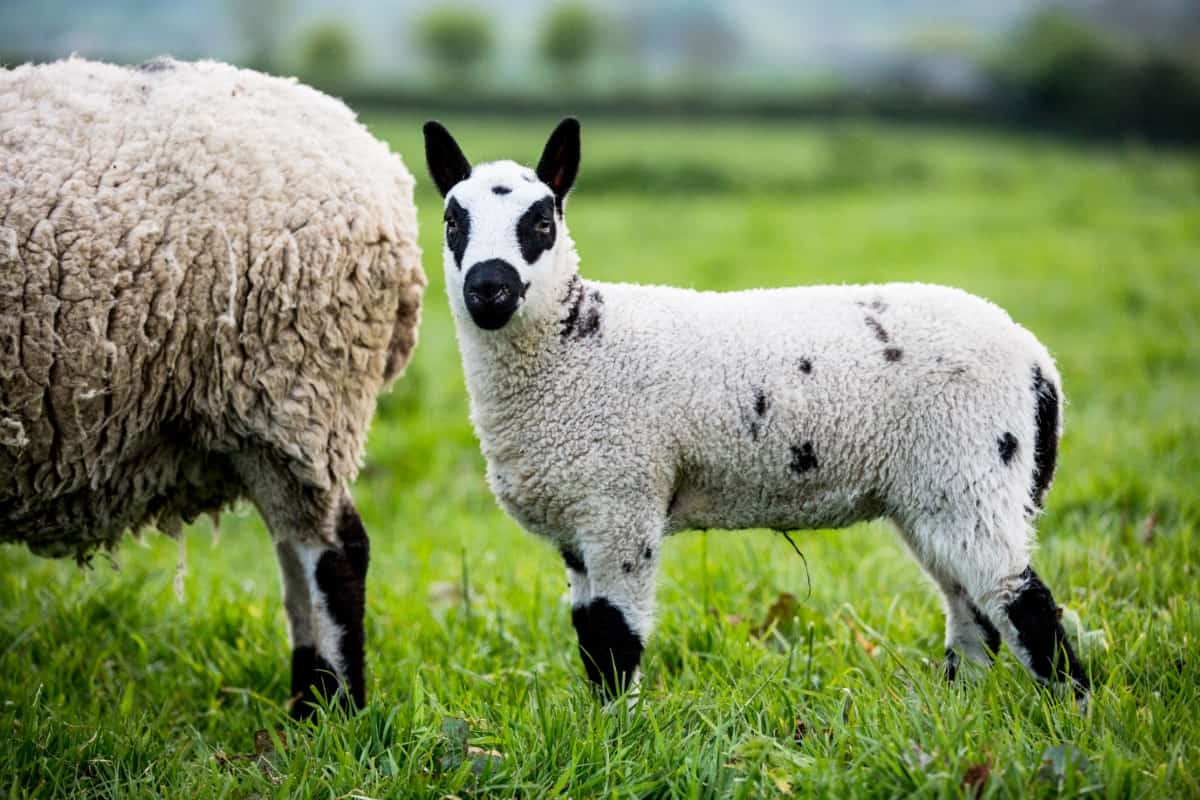Diving into the world of Kerry Hill sheep offers a unique opportunity for sustainable farming enthusiasts and livestock farmers alike. Renowned for their striking appearance and quality wool production, Kerry Hill sheep care is a rewarding endeavour that blends traditional practices with modern husbandry techniques.

Here we learn about raising Kerry Hill sheep, covering everything from Kerry Hill sheep for sale, lambing management, and breeding to health, feeding, and fencing requirements. Whether you want to enhance your farm’s livestock diversity or focus on Kerry Hill wool production and meat quality, understanding the basics of Kerry Hill sheep genetics and veterinary care is essential for successful farming.
Raising Kerry Hill Sheep
History and Origin
With its distinct lineage, the Kerry Hill sheep hails from the border county of Powys in Wales, known for its picturesque Kerry Hills, where the breed first emerged. This breed’s evolution over the years showcases a dedicated effort towards preserving its unique characteristics while adapting to modern farming needs, making it a cherished choice among sheep enthusiasts for its historical significance and farming utility.
Characteristics and Appearance
Characterised by their distinctive black and white faces, Kerry Hill sheep captivate onlookers and farmers with their unique aesthetic appeal. Beyond their striking looks, these sheep are known for their robust build and adaptability to various climates, making them a versatile breed for different farming environments. Their appearance contributes to their popularity and symbolises the breed’s resilience and adaptability.
Kerry Hill Sheep Price
When considering adding Kerry Hill sheep to your farm, it’s important to note that prices vary widely based on age, pedigree, and purpose, ranging from $100 to $400 per sheep. This price range reflects the breed’s genetic quality and potential for wool and meat production, making it a significant investment for farmers committed to raising Kerry Hill sheep.
Kerry Hill Sheep Lifespan
Kerry Hill sheep are known for their longevity, typically 10 to 12 years, which is a testament to their hardiness and the effectiveness of proper care and management. This extended lifespan allows farmers to develop a sustainable breeding program and ensure a steady production of wool and meat over the years.
Kerry Hill Sheep Size and Weight
On average, Kerry Hill sheep exhibit a moderate size, with ewes weighing around 120 to 150 pounds (54 to 68 kg) and rams slightly larger at 160 to 200 pounds (72 to 90 kg). This size range makes them manageable for various farming operations, from small homesteads to larger commercial farms.
Breed Standards
Physical Attributes
Kerry Hill sheep are distinguished by their physical attributes, including the iconic black markings on their faces, ears, and legs, contrasted with their otherwise white wool. This distinctive pattern, along with their well-proportioned bodies and strong limbs, aligns with the breed standards that emphasise both form and function, catering to farmers focused on aesthetics and productivity.
Temperament and Behavior
The temperament of Kerry Hill sheep is generally docile and friendly, making them a suitable choice for farms with varied livestock and families. Their calm nature eases handling, shearing, and medical treatment, contributing to the overall ease of Kerry Hill sheep husbandry.
In case you missed it: Bergamasca Sheep: Raising Facts, Profile, Characteristics, Uses, and Care

Getting Started with Kerry Hill Sheep
Selecting Your First Sheep: What to Look For
Choosing your first Kerry Hill sheep involves careful consideration of health, conformation, and temperament, ensuring a strong foundation for your flock. Opting for sheep with a clear health record, good physical structure, and calm demeanour sets the stage for a successful and manageable sheep farming experience.
Setting Up Your Farm for Kerry Hills: Shelter, Fencing, and Pasture
Preparing your farm for Kerry Hill sheep requires attention to shelter, fencing, and pasture. Adequate shelter protects the sheep from harsh weather, while sturdy fencing ensures their safety and prevents escapes. A well-managed pasture provides essential nutrition and space for grazing, contributing to the overall well-being of the flock.
Nutrition and Feeding
Basic Nutritional Needs of Kerry Hill Sheep
Kerry Hill sheep thrive on a diet that includes a balance of forage, grains, and minerals, catering to their basic nutritional needs. Providing high-quality hay or pasture and access to clean water and mineral supplements supports their health, growth, and productivity in wool and meat.
Feeding Strategies: From Lambs to Adults
Effective feeding strategies for Kerry Hill sheep vary from lambs to adults, with lambs requiring a diet rich in protein for growth and adults benefiting from a balanced mix of forage and grains to maintain their condition. Seasonal adjustments and body condition monitoring help tailor the diet to meet the flock’s changing nutritional needs.
Health and Wellness
Common Health Issues and Prevention
Kerry Hill sheep, like all livestock, are susceptible to certain health issues, but with proper management and preventative measures, risks can be minimised. Routine health screenings, maintaining a hygienic environment, and promptly addressing health issues help prevent common illnesses and promote the general well-being of the group.
Routine Veterinary Care and Vaccinations
Regular veterinary maintenance, encompassing vaccinations and parasite management, is crucial for preserving the health of Kerry Hill sheep. A regular health care schedule with a qualified veterinarian ensures the flock receives necessary vaccinations and treatments, preventing disease outbreaks and maintaining optimal health.
Breeding Kerry Hill Sheep
Understanding Genetics and Breeding Principles
Breeding Kerry Hill sheep successfully requires a solid understanding of genetics and breeding principles, focusing on traits such as wool quality, hardiness, and temperament. Selecting the best breeding stock based on these criteria ensures the improvement and sustainability of the flock over generations.
Managing the Breeding Season: Estrus, Mating, and Pregnancy Care
Effective management of the breeding season involves monitoring estrus cycles, ensuring proper mating, and providing care during pregnancy. Timely identification of estrus and mating, followed by attentive pregnancy care, maximises lambing success and promotes the health of both ewes and their offspring, contributing to the overall productivity of your Kerry Hill sheep farming venture.
In case you missed it: Laticauda Sheep: Raising Facts, Profile, Characteristics, and Uses

Lambing Management
Preparing for Lambing: Equipment and Signs of Labor
Effective lambing management begins with thorough preparation, ensuring all necessary equipment, such as lambing pens, heat lamps, and birthing supplies, is readily available and in good condition. Familiarising yourself with the signs of labour in Kerry Hill ewes, including restlessness, isolation from the flock, and physical changes, is crucial for providing timely assistance and ensuring a successful birthing process.
Post-Lambing Care: Ensuring Health of Ewes and Lambs
After lambing, the focus shifts to the health and well-being of the ewes and their newborn lambs. Immediate care involves ensuring lambs receive colostrum within the first few hours, monitoring for bonding between ewe and lamb, and checking for any signs of health issues. Adequate nutrition for the ewe is essential to support milk production and recovery while maintaining a clean and safe environment to prevent diseases.
Wool Production
Characteristics of Kerry Hill Wool
Kerry Hill wool is known for its moderate fineness and good staple length, making it suitable for various wool products, from yarns to textiles. The wool’s natural whiteness offers excellent dyeing properties, enhancing its value in the market. Understanding these characteristics allows for better management of wool production and maximises the quality of the final product.
Shearing Techniques and Wool Handling
Proper shearing techniques and wool handling are vital to maintaining the quality of Kerry Hill wool. Shearing should be done annually to ensure the sheep’s health and comfort while preserving the wool’s length and cleanliness. Efficient handling and storage of the shorn wool prevent contamination and damage, keeping it in prime condition for processing and sale.
Market and Products
Marketing Your Sheep and Wool
Marketing Kerry Hill sheep and wool effectively requires understanding the target market, whether it’s local crafters, textile manufacturers, or the meat industry. Utilising online platforms, attending agricultural shows, and engaging with local farming networks are effective ways to reach potential buyers.
Diversifying Products: Meat, Wool, and Breeding Stock
Diversification is key to maximising the profitability of Kerry Hill sheep farming. Offering a range of products, from high-quality wool and premium meat to breeding stock known for their desirable genetics, can cater to various market segments. This approach enhances revenue streams and builds resilience against market fluctuations, securing a sustainable future for your farming operation.
In case you missed it: Ouessant Sheep Breed: Origin, Characteristics, Uses, Weight, Size, Lifespan, and Price

Conclusion
Kerry Hill Sheep offers a multifaceted opportunity for farmers, combining the joys of lambing management and wool production with the business acumen required for effective market engagement.
- Feed Your Flock for Less: Top 10 Tips to Save on Chicken Feed
- Ultimate Guide to Ossabaw Island Hog: Breeding, Raising, Diet, and Care
- Hatching Answers: The Top 10 Reasons Your Chickens Aren’t Laying Eggs
- Eggs and Economics: Breaking Down the Cost of Raising Backyard Chickens
- Defend Your Greens: Proven Methods to Keep Iguanas Out of Your Garden
- Ultimate Guide to Cinnamon Queen Chicken: A Comprehensive Guide for Beginners
- Ultimate Guide to California Tan Chicken: Breeding, Raising, Diet, Egg-Production and Care
- Ultimate Guide to Marsh Daisy Chicken: Breeding, Raising, Diet, and Care
- 10 Types of Chicken Farming Businesses You Can Start for Profits